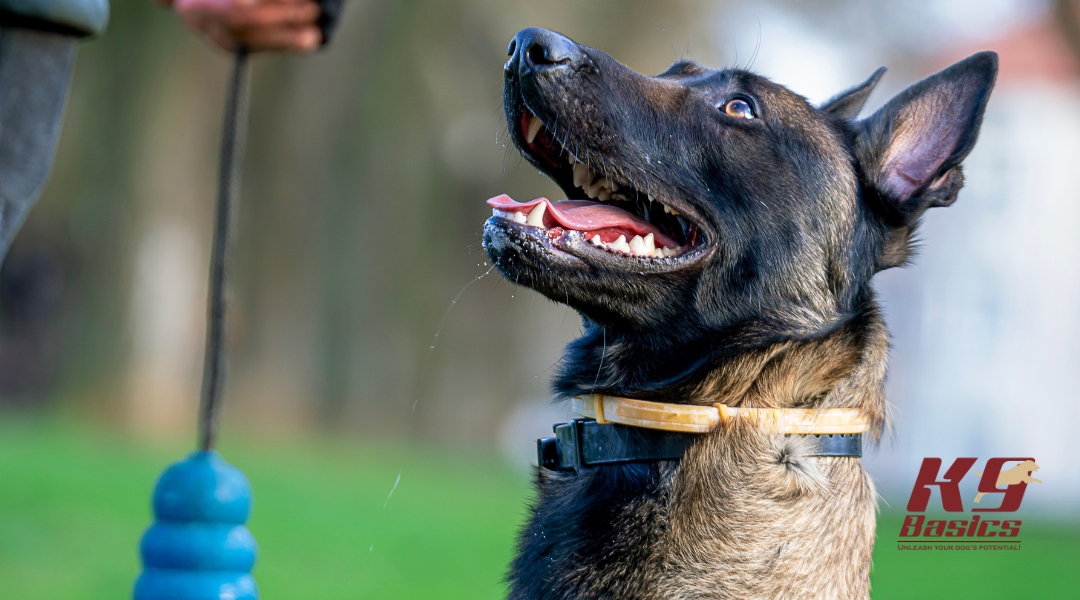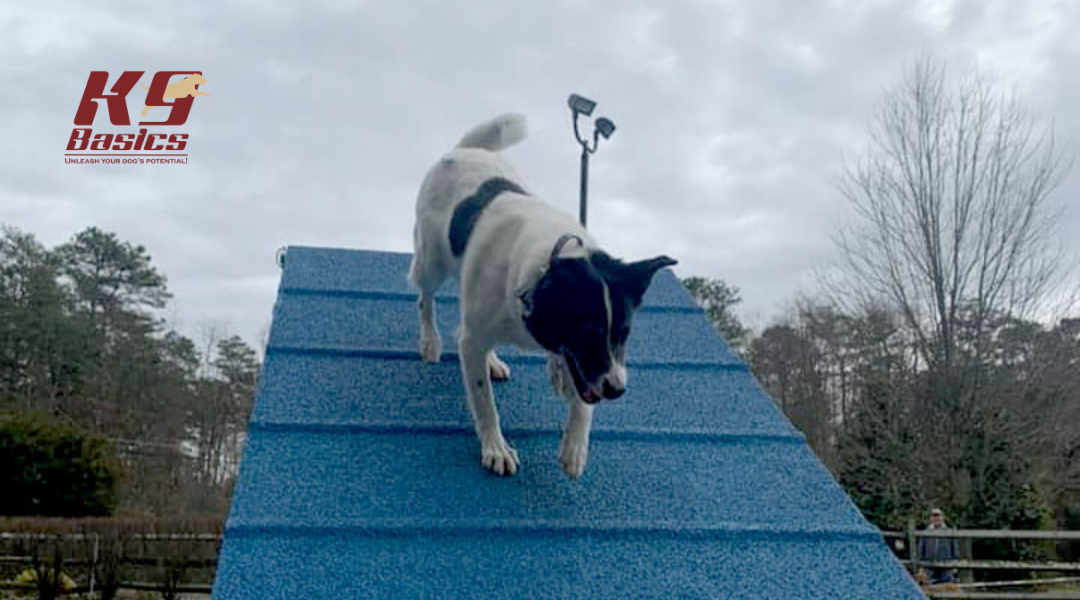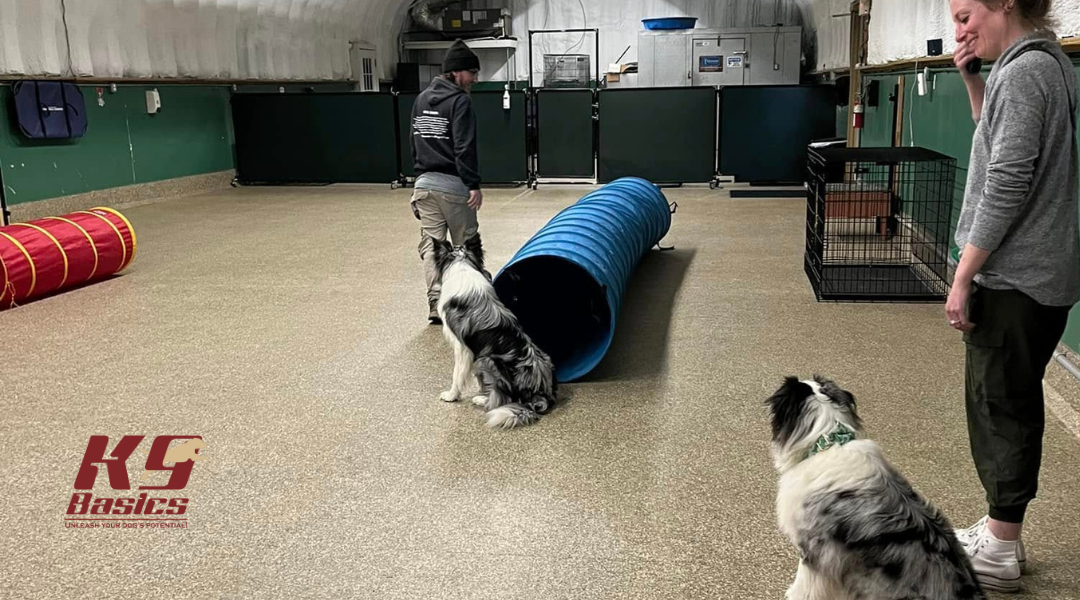Border Collies, German Shepherds, Belgian Malinois; these names often come up when people think of the smartest, hardest-working dogs. It’s no surprise that searches for “Border Collie training” are on the rise, as more owners look for ways to manage the energy, intelligence, and drive that come with these remarkable breeds.
At K9 Basics, we understand that high-drive dogs need more than just long walks or casual obedience. They need outlets for both their bodies and their minds. Without the right structure, these dogs can put their instincts to work in all the wrong ways: Chewing furniture, digging holes, or chasing anything that moves.
With the right training, however, those same instincts can be transformed into focus, control, and a lifetime of rewarding partnership.

What Makes a Dog a “Working Breed”?
Working dog breeds were developed with a purpose in mind—herding, guarding, pulling, or protecting. Unlike companion or show breeds, these dogs were selectively bred for traits like stamina, focus, intelligence, and drive. That’s why they often need more stimulation than the average pet. A working breed doesn’t just want a job; it thrives when given one.
From German Shepherds used in police and military work, to Belgian Malinois excelling in protection, to Swiss and Burmese Mountain Dogs pulling loads, these dogs are wired for tasks that demand both physical energy and mental focus.
Without structured outlets, their instincts don’t disappear; they simply find expression in less desirable ways, like digging, chewing, or trying to herd people around the house.
Border Collies and Other High-Drive Breeds
Border Collies are perhaps the best-known example of a high-drive working breed. Bred for herding sheep, they’re famous for their quick intelligence, problem-solving skills, and relentless energy. But they’re not alone. Breeds like Malinois, Shepherds, and even some Retrievers share this same “work-first” mentality.
What sets Border Collies apart is their intense focus. Their natural herding instinct means they often crave mental work just as much as physical exercise. A two-hour walk may tire out other breeds, but a Border Collie (or Malinois, or working-line Shepherd) still needs mental challenges, training drills, puzzle games, or structured obedience sessions.
Showline versions of these breeds (like show German Shepherds) often have less drive and energy, because they were bred for appearance rather than work. Understanding these differences is critical.
A working-line dog may ignore food or toys in favor of chasing, herding, or hunting, because those drives run deeper than basic rewards.

The Core Needs of Working Dogs
High-drive working breeds aren’t just pets; they’re athletes, thinkers, and problem-solvers. While many owners assume daily exercise is enough, the truth is that these dogs also crave mental work and structured outlets for their instincts. Without both, their energy and intelligence can quickly turn into frustration.
Why Mental Work Matters as Much as Physical Work
Running, hiking, or playing fetch may tire out a dog’s body, but without challenges that engage the brain, working breeds rarely feel fulfilled. Mental stimulation, puzzle toys, obedience drills, tracking games, or problem-solving exercises teach them to focus on their “work drive” rather than constantly seeking outlets for excess energy. The key is to give them tasks that make them think, not just move.
Outlets for Prey Drive: Turning Instinct Into Positive Action
Many working breeds, especially Border Collies, Malinois, and Retrievers, have strong prey drives. Left unmanaged, this can show up as chasing cars, herding children, or ignoring commands in pursuit of movement. Instead of fighting this instinct, training should provide structured outlets, flirt poles, tug games, controlled fetch sessions, or herding exercises. By giving them an acceptable way to use that drive, we prevent them from finding their own (less desirable) outlets.
Teaching the “Off-Switch”: Work Mode vs. Rest Mode
Just as important as teaching dogs how to work is teaching them when to stop. Some high-drive dogs will turn down food or rest just to keep chasing or “working.” The ability to shift from high intensity to calm relaxation is what we call the “off-switch.”
Through consistent routines, crate time after walks, calm obedience exercises after play, we teach dogs that rest is part of the job. This balance between activity and recovery prevents burnout and keeps drive from spilling into destructive behaviors.

K9 Basics’ Training Approach
At K9 Basics, we know that high-drive dogs need more than one-size-fits-all obedience lessons. Our approach is built on balancing mental stimulation, physical outlets, and structured routines so dogs can channel their instincts in positive, controlled ways. By understanding what truly motivates each individual dog, we create training plans that build trust, focus, and long-term success.
Building Focus Through Games and Puzzles
Mental stimulation is at the heart of working dog training. We use interactive games and puzzle exercises to challenge a dog’s mind and teach them how to concentrate on tasks. Whether it’s scent work, problem-solving activities, or structured fetch drills, these exercises give dogs the satisfaction of “working” while also reinforcing obedience. The result is a calmer, more engaged dog that learns to focus in high-drive situations.
Structured Obedience for High-Drive Breeds
While play and puzzles are essential, structure is what keeps a working dog balanced. Our obedience training emphasizes clear expectations and consistent communication. Commands aren’t just about compliance—they’re about giving the dog purpose. Teaching skills like sit, down, stay, and recall under distraction helps channel energy into control. With high-drive breeds, obedience becomes a framework that prevents chaos and builds confidence.
Influencing Behavior in Prey Drive: How to Enter and Exit Drive States
One of the most unique aspects of our training is teaching dogs how to work in and out of the drive. Many owners struggle because once their dog’s prey instinct kicks in, food and verbal commands seem to lose all meaning. We train dogs to “switch on” when it’s time to work and “switch off” when it’s time to relax.
This control over drive states is crucial for breeds like Border Collies, Malinois, and Shepherds, who otherwise risk staying stuck in a hyper-aroused state. By giving them controlled outlets for prey drive, like tug, chase games, or advanced obedience, we build a reliable off-switch.
Training for All Ages: From Puppies to Mature Dogs
Our methods aren’t limited to puppies. High-drive breeds require structure at every stage of life. For puppies, we focus on early socialization, crate training, and introducing mental work to set the foundation. Adolescent dogs benefit from advanced obedience and controlled outlets for their energy.
Mature dogs continue to need stimulation, but training often shifts toward maintaining focus and managing drive without overexertion. At every stage, our goal is the same: to give dogs the tools to thrive in both work and home life.

Frequently Asked Questions
How Much Exercise Does a Border Collie Really Need?
Border Collies are among the most energetic dog breeds in the world. A simple walk around the block isn’t enough to meet their needs. Most Border Collies require at least 90 minutes to 2 hours of physical activity daily, along with mental work such as puzzle games, obedience training, or herding-style exercises. Without this combination, they may become restless or destructive. The key isn’t just duration, but quality: targeted activities that challenge both body and mind.
Are Border Collies Good Family Pets?
Yes, but with the right family. Border Collies can be incredibly loving, loyal, and playful companions, but they thrive best in households that can match their energy and provide consistent structure.
Families with active lifestyles, children who enjoy engaging with pets, or adults who enjoy training and outdoor activities are ideal. However, without proper outlets, a Border Collie may try to “herd” kids or channel its drive into less desirable behaviors. With training and mental stimulation, they make excellent family dogs.
What If My Dog’s Drive Is “Too Much to Handle”?
It’s not uncommon for owners to feel overwhelmed by the intensity of working breeds like Border Collies, Malinois, or German Shepherds. If your dog’s drive feels unmanageable, the first step is to redirect that energy into structured outlets: obedience training, tug games, scent work, or other tasks that give them purpose.
Professional guidance can make a dramatic difference, helping you identify what motivates your dog and how to balance freedom with structure. At K9 Basics, we specialize in teaching dogs to switch off when work is done, ensuring their drive becomes an asset rather than a frustration.
Channel Your Dog’s Drive? K9 Basics Can Help
Call us at (866) 592-2742 or, if you’re from New Jersey, Pennsylvania, Delaware, or New York, visit us at 131 Kenilworth Road, Marlton, NJ 08053, to learn more about our group training classes.
Also, browse our blog and social media for various topics about dogs and their lives with us!
https://k9basics.com/working-dog-breed-training-k9-basics-expert-methods/
